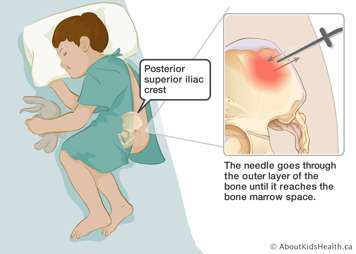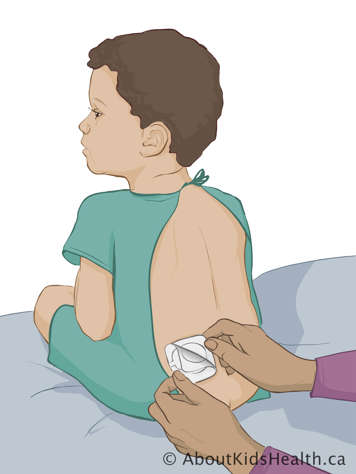To confirm that your child has leukemia and assess their response to therapy, doctors do a bone marrow aspirate and sometimes a biopsy.
What is a bone marrow aspirate? What is a biopsy?
- A bone marrow aspirate collects a small amount of marrow, the spongy tissue inside bones where blood cells are made.
- A bone marrow biopsy removes a small amount of bone and bone marrow.
Why are they taken?
The bone marrow aspirate looks for leukemic cells. It also identifies the exact type of leukemia, including possible gene changes in the leukemia cells.
A biopsy of your child's bone marrow is only done if there are not enough cells in the aspirate sample.

Preparing for the procedure
You will be asked to sign a consent form. Your child's doctor should explain:
- why your child needs a bone marrow aspirate or biopsy, and whether it will be done on one side or both sides
- the risks
- how the procedure works
- what the results may mean
Remember to tell the doctor if your child is taking any medicines, or if they have any allergies or history of reactions, including anaesthetics.
How the procedure works
A paediatrician who specializes in hematology/oncology usually performs the bone marrow tests. Your child’s stomach needs to be empty, since they will be sedated during the procedure. Your child’s medical team will let you know when your child should stop eating and drinking on the day of the lumbar puncture.
The procedure will usually take place in a treatment or an operating room and takes about 10 to 15 minutes.
As a parent, staying calm will help your child through the test. The medical team will try to ensure your child is as comfortable as possible.
To take your child's bone marrow aspirate:
- A nurse puts a small patch of numbing cream to numb the skin at the area where the bone marrow will be taken about 15-30 minutes prior to the procedure. Your child will be given sleeping medicine (sedatives) so they will not feel pain during the test.
- Your child lies down on their side.
- Their lower back will be disinfected and the physician will inject a local anaesthetic, to numb the area.
- The doctor inserts the aspirate needle through the skin until it touches the top of the hip bone, called the posterior superior iliac crest. This is the largest and uppermost bone in the pelvis and contains a large amount of bone marrow. If a child is obese, they may need to lie on their back so that the physician can take aspirate along the front part of their pelvis.
- Once the needle touches the hip bone, the doctor pushes the needle through the hard outer layer of the hip bone and into the bone marrow space.
- A syringe is then attached to the needle to draw out (aspirate) a small amount of the liquid bone marrow from your child. Sometimes several attempts are required in order to obtain an adequate sample. This may include the opposite side as well.
- The bone marrow sample is then taken to a lab for analysis.
- Apply ice packs to the site.
- Encourage your child to walk.
- Give your child pain medicine such as acetaminophen. In rare cases, morphine may be required for pain management. Your doctor can provide you with a prescription if necessary.
- Bleeding: There is a higher chance of this happening with children who have pre-existing bleeding problems. In this case, the physician will order platelet and/or plasma transfusions before your child's test to prevent any bleeding that might occur. If bleeding does occur, putting pressure on the biopsy site may help.
- Infection: If the skin or bone becomes infected and is painful, or there is redness and swelling, the doctor may give your child antibiotics through an IV or by mouth.
- more tenderness, pain, redness, or swelling at the biopsy site
- a fever
- bleeding or drainage, such as pus, from the biopsy site. If your child is bleeding, put pressure on the site and call your doctor.

When a bone marrow biopsy is required, your child's doctor inserts a different needle into the posterior superior iliac crest. While anchoring the needle in the hip bone, they extract a solid piece of the bone marrow.
Very rarely the bone marrow aspirate and/or biopsy are done while your child is awake. This only happens if the doctor decides it is unsafe to have your child receive sedation medicine.
After the procedure
Your child will lie down for 10 to 15 minutes after the procedure.
The bone marrow site may be sore for a few days. There may also be a bruise on the site, which will not take too long to heal. To help your child feel better:
What complications can occur?
Bone marrow aspirates and biopsies are generally safe procedures. While your child may feel mildly sore for up to one to two days following the procedure, serious complications rarely occur.
Sometimes problems occur at the site where the aspirate or biopsy was taken. These include:
Call your doctor right away if your child has: